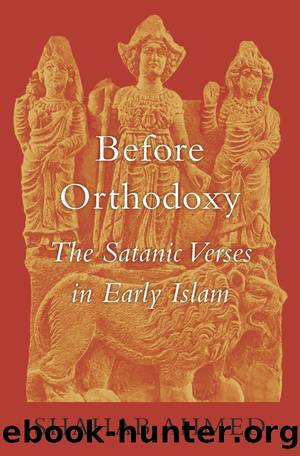Before Orthodoxy by Shahab Ahmed

Author:Shahab Ahmed [Ahmed, Shahab]
Language: eng
Format: azw3, mobi, epub
Publisher: Harvard University Press
Published: 2017-04-23T16:00:00+00:00
RiwÄyahs 35 to 44: Conclusions
The most remarkable feature in the nine riwÄyahs attributed to Ibn âAbbÄs (and the tenth, RiwÄyah 42, that we have attributed to him bi-al-maânÄ) is their hermeneutical consistency. On two fundamental points, they all present the same interpretation of the incident: they agree that the Prophet uttered the Satanic verses; and none of them makes any mention of the Prophetâs desire, the default gloss for tamannÄ within the wording of the narratives being ârecitationâ [qirÄâah, tilÄwah]âwhich is expressly stated in RiwÄyah 37. On this second point, it is interesting to note the gloss of tamannÄ in another tafsÄ«r transmission attributed to Ibn âAbbÄs, that of âAlÄ« b. AbÄ« Ṭalḥah al-WÄlibÄ« al-Ḥimṣī (d. 143):579 âHis words, âWhen he tamannÄ, Satan cast into his umniyyahâ: when he spoke, Satan cast into his speech [idhÄ á¸¥addatha alqÄ al-shayá¹Än fÄ« ḥadÄ«thi-hi].â580 Here, too, tamannÄ is glossed not as âdesireâ but as the Prophetâs utterances.581
The variations of note in the riwÄyahs attributed to Ibn âAbbÄs are three. First is the distinctive hermeneutical elaboration that is present in RiwÄyahs 36, 37, and 38, but nowhere else, whereby Satan deceives the Prophet by appearing to him in the form of JibrÄ«l. RiwÄyahs 37 and 38 name the Satan in question as one al-Abyaá¸. These motifs, while absent from the other riwÄyahs, effect a hermeneutical elaboration that is additional to but does not contradict the fundamental two points stated above that constitute the common hermeneutical position of the reports attributed to Ibn âAbbÄs. The second variation is in RiwÄyah 35, which seems to imply the ârepetitionâ motif contained in RiwÄyah 34. However, as noted above, it is unlikely that the reader unaware of RiwÄyah 34 would detect the ârepetitionâ motif in RiwÄyah 35, and again, RiwÄyah 35 in no way contradicts RiwÄyahs 36 to 44. On a third point, the two transmission traditions differ: RiwÄyahs 40 and 42 from âUthmÄn b. al-Aswad contain a correction scene, while RiwÄyahs 43 and 44 from AbÅ« Bishr do not. We will take up this point again in the discussion of RiwÄyahs 40 to 47 below.
RiwÄyahs 35 to 44 all present what is essentially the same hermeneutical elaboration of the Satanic verses incident. It is further instructive to note here that my notion that reports may meaningfully be assessed on the basis of shared hermeneutical elaboration is not my methodological innovation: it is apparently shared by AbÅ« al-Layth al-SamarqandÄ«, who followed his citation of RiwÄyah 36 (from AbÅ« á¹¢Äliḥ) with RiwÄyah 41 (from SaâÄ«d b. Jubayr) by saying, âSaâÄ«d b. Jubayr relates something similar to thatâ582 (i.e., something similar to RiwÄyah 36). A cursory comparison of the two riwÄyahs shows little similarity in wording. In categorizing them as âsimilar,â AbÅ« al-Layth can be referring only to their shared hermeneutical position. The fact that this interpretation is attributed to Ibn âAbbÄs by six different scholars transmitting knowledge in different cities clearly shows that the idea that the Prophet uttered the Satanic verses was seen by the late first- and
Download
Before Orthodoxy by Shahab Ahmed.mobi
Before Orthodoxy by Shahab Ahmed.epub
This site does not store any files on its server. We only index and link to content provided by other sites. Please contact the content providers to delete copyright contents if any and email us, we'll remove relevant links or contents immediately.
The History of Jihad: From Muhammad to ISIS by Spencer Robert(2507)
Nine Parts of Desire by Geraldine Brooks(2282)
The Turkish Psychedelic Explosion by Daniel Spicer(2246)
The First Muslim The Story of Muhammad by Lesley Hazleton(2158)
The Essential Rumi by Coleman Barks(1931)
1453 by Roger Crowley(1881)
The Last Mughal by William Dalrymple(1792)
Trickster Travels: A Sixteenth-Century Muslim Between Worlds by Davis Natalie Zemon(1783)
Muhammad: His Life Based on the Earliest Sources by Martin Lings(1569)
by Christianity & Islam(1564)
God by Aslan Reza(1561)
A Concise History of Sunnis and Shi'is by John McHugo(1511)
Magic and Divination in Early Islam by Emilie Savage-Smith;(1456)
No God But God by Reza Aslan(1436)
The Flight of the Intellectuals by Berman Paul(1397)
Art of Betrayal by Gordon Corera(1366)
Nothing to Envy by Barbara Demick(1326)
What the Qur'an Meant by Garry Wills(1322)
Getting Jesus Right: How Muslims Get Jesus and Islam Wrong by James A Beverley & Craig A Evans(1276)
